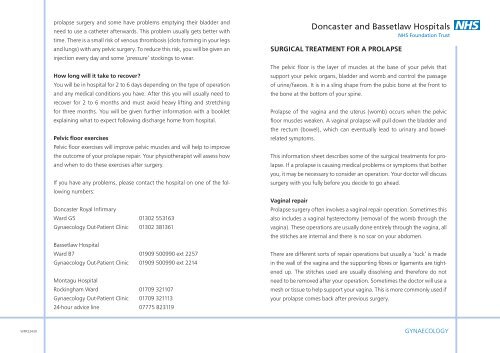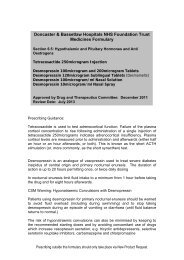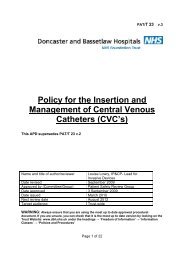surgical treatment for a prolapse - Doncaster and Bassetlaw ...
surgical treatment for a prolapse - Doncaster and Bassetlaw ...
surgical treatment for a prolapse - Doncaster and Bassetlaw ...
Create successful ePaper yourself
Turn your PDF publications into a flip-book with our unique Google optimized e-Paper software.
WPR22430<br />
<strong>prolapse</strong> surgery <strong>and</strong> some have problems emptying their bladder <strong>and</strong><br />
need to use a catheter afterwards. This problem usually gets better with<br />
time. There is a small risk of venous thrombosis (clots <strong>for</strong>ming in your legs<br />
<strong>and</strong> lungs) with any pelvic surgery. To reduce this risk, you will be given an<br />
injection every day <strong>and</strong> some ‘pressure’ stockings to wear.<br />
How long will it take to recover?<br />
You will be in hospital <strong>for</strong> 2 to 6 days depending on the type of operation<br />
<strong>and</strong> any medical conditions you have. After this you will usually need to<br />
recover <strong>for</strong> 2 to 6 months <strong>and</strong> must avoid heavy lifting <strong>and</strong> stretching<br />
<strong>for</strong> three months. You will be given further in<strong>for</strong>mation with a booklet<br />
explaining what to expect following discharge home from hospital.<br />
Pelvic floor exercises<br />
Pelvic floor exercises will improve pelvic muscles <strong>and</strong> will help to improve<br />
the outcome of your <strong>prolapse</strong> repair. Your physiotherapist will assess how<br />
<strong>and</strong> when to do these exercises after surgery.<br />
If you have any problems, please contact the hospital on one of the following<br />
numbers:<br />
<strong>Doncaster</strong> Royal Infirmary<br />
Ward G5 01302 553163<br />
Gynaecology Out-Patient Clinic 01302 381361<br />
<strong>Bassetlaw</strong> Hospital<br />
Ward B7 01909 500990 ext 2257<br />
Gynaecology Out-Patient Clinic 01909 500990 ext 2214<br />
Montagu Hospital<br />
Rockingham Ward 01709 321107<br />
Gynaecology Out-Patient Clinic 01709 321113<br />
24-hour advice line 07775 823119<br />
SURGICAL TREATMENT FOR A PROLAPSE<br />
The pelvic floor is the layer of muscles at the base of your pelvis that<br />
support your pelvic organs, bladder <strong>and</strong> womb <strong>and</strong> control the passage<br />
of urine/faeces. It is in a sling shape from the pubic bone at the front to<br />
the bone at the bottom of your spine.<br />
Prolapse of the vagina <strong>and</strong> the uterus (womb) occurs when the pelvic<br />
floor muscles weaken. A vaginal <strong>prolapse</strong> will pull down the bladder <strong>and</strong><br />
the rectum (bowel), which can eventually lead to urinary <strong>and</strong> bowelrelated<br />
symptoms.<br />
This in<strong>for</strong>mation sheet describes some of the <strong>surgical</strong> <strong>treatment</strong>s <strong>for</strong> <strong>prolapse</strong>.<br />
If a <strong>prolapse</strong> is causing medical problems or symptoms that bother<br />
you, it may be necessary to consider an operation. Your doctor will discuss<br />
surgery with you fully be<strong>for</strong>e you decide to go ahead.<br />
Vaginal repair<br />
Prolapse surgery often involves a vaginal repair operation. Sometimes this<br />
also includes a vaginal hysterectomy (removal of the womb through the<br />
vagina). These operations are usually done entirely through the vagina, all<br />
the stitches are internal <strong>and</strong> there is no scar on your abdomen.<br />
There are different sorts of repair operations but usually a ‘tuck’ is made<br />
in the wall of the vagina <strong>and</strong> the supporting fibres or ligaments are tightened<br />
up. The stitches used are usually dissolving <strong>and</strong> there<strong>for</strong>e do not<br />
need to be removed after your operation. Sometimes the doctor will use a<br />
mesh or tissue to help support your vagina. This is more commonly used if<br />
your <strong>prolapse</strong> comes back after previous surgery.<br />
GYNAECOLOGY
Sacrospinous fixation<br />
To hold the vagina up more strongly, sometimes a stitch or two is put in<br />
deeper inside you. This stitch goes in to a strong ligament in the pelvis, the<br />
sacrospinous ligament. This part of the operation is called sacrospinous<br />
fixation. This part of the operation aims to prevent your <strong>prolapse</strong> coming<br />
back <strong>and</strong> also helps to keep the normal length of your vagina if you are<br />
sexually active. There is a risk with this extra fixation stitch that damage<br />
can occur to blood vessels, bowel, urinary system or nerves. The stitch<br />
also makes the operating time longer.<br />
Sacrocolpopexy<br />
If the <strong>prolapse</strong> is complicated or has come back after surgery, it may be<br />
necessary to per<strong>for</strong>m an operation through a cut in your abdomen. The<br />
sacrocolpopexy fixes your vagina to the bone at the back of your pelvis<br />
(the sacrum) to give stronger support. Material or mesh is often used <strong>and</strong><br />
this helps to hold things in place. There is a small risk that this material<br />
can cut through into the vagina or get infected. Because the bowel <strong>and</strong><br />
urinary systems are close by, there is a risk that they could be damaged in<br />
this operation. A further operation may then be needed to sort out these<br />
problems. Because the sacrocolpopexy is per<strong>for</strong>med through a cut in your<br />
abdomen, the operation usually takes longer to carry out <strong>and</strong> longer to<br />
recover from than surgery done through the vagina.<br />
Posterior intravaginal sling plasty<br />
Sometimes when the vagina <strong>prolapse</strong>s after a hysterectomy, a mesh is<br />
used to anchor the vagina. The operation is done through the vagina. You<br />
will also have two small cuts on your buttocks.<br />
As the mesh lies on either side of the rectum, there is a small risk that the<br />
rectum could be injured during the operation or later when the tape erodes<br />
through. Should this happen, the mesh is removed <strong>and</strong> usually the rectum<br />
heals over. Recovery is as following repair operations.<br />
What sort of anaesthetic will I have?<br />
Prolapse surgery may be carried out under general anaesthetic (while<br />
you are asleep) or sometimes under spinal anaesthetic so that you can<br />
be awake during the operation but without any pain or sensation. The<br />
anaesthetist will discuss the anaesthetic be<strong>for</strong>e the operation. If you have<br />
any other medical problems, then these may require special attention be<strong>for</strong>e<br />
surgery. Please ask <strong>for</strong> the leaflet ‘Anaesthesia <strong>and</strong> You’, which may<br />
help answer some of your questions.<br />
What are the risks?<br />
Sometimes the operation you have <strong>for</strong> <strong>prolapse</strong> will change from the original<br />
plan, either because of what the doctor finds or difficulties during the<br />
operation. In this case your doctor will do what he or she thinks is best <strong>for</strong><br />
you at that time. However, these risks should be explained be<strong>for</strong>e surgery<br />
so that you can agree, or not, to the surgeon taking this action.<br />
About a third of women who have <strong>prolapse</strong> surgery need more than one<br />
operation because the <strong>prolapse</strong> comes back or a different type of <strong>prolapse</strong><br />
develops. For example, a <strong>prolapse</strong> of the womb can occur after an<br />
operation <strong>for</strong> <strong>prolapse</strong> of the vaginal <strong>and</strong> vice versa.<br />
Prolapse surgery usually improves or cures the symptom of ‘something<br />
coming down below’ or the lump in the vagina. Symptoms relating to<br />
the bowel or bladder such as constipation or incontinence are often not<br />
improved. Similarly, problems with your sex life may not be improved with<br />
surgery.<br />
If a mesh or extra tissue is used in a <strong>prolapse</strong> operation, there is a chance<br />
that this can get infected or cut through (erode). This may require<br />
a further operation to remove part of the mesh or repair any damage.<br />
Occasionally, some new bowel or bladder symptoms develop after<br />
<strong>prolapse</strong> surgery, which may require further <strong>treatment</strong> in the future,<br />
including further surgery. Some women develop incontinence after<br />
GYNAECOLOGY














